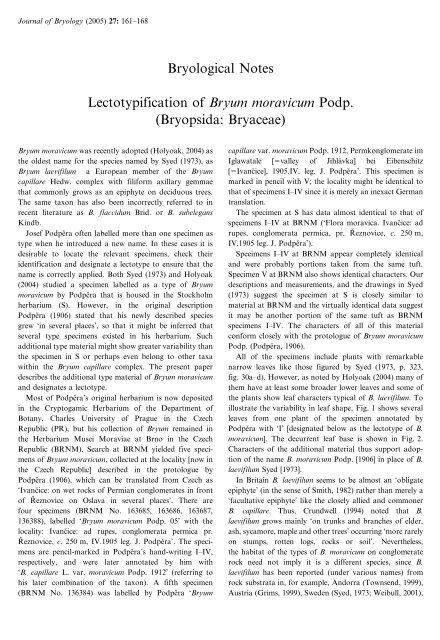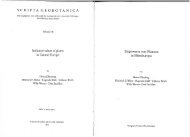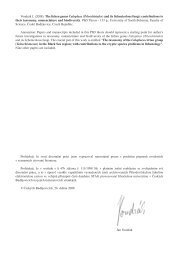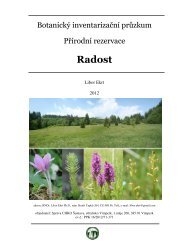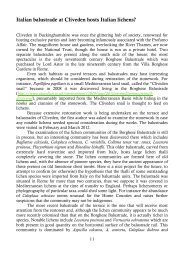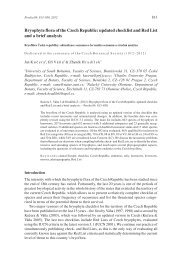Bryological Notes Lectotypification of Bryum moravicum Podp ...
Bryological Notes Lectotypification of Bryum moravicum Podp ...
Bryological Notes Lectotypification of Bryum moravicum Podp ...
Create successful ePaper yourself
Turn your PDF publications into a flip-book with our unique Google optimized e-Paper software.
Journal <strong>of</strong> Bryology (2005) 27: 161–168<br />
<strong>Bryological</strong> <strong>Notes</strong><br />
<strong>Lectotypification</strong> <strong>of</strong> <strong>Bryum</strong> <strong>moravicum</strong> <strong>Podp</strong>.<br />
(Bryopsida: Bryaceae)<br />
<strong>Bryum</strong> <strong>moravicum</strong> was recently adopted (Holyoak, 2004) as<br />
the oldest name for the species named by Syed (1973), as<br />
<strong>Bryum</strong> laevifilum a European member <strong>of</strong> the <strong>Bryum</strong><br />
capillare Hedw. complex with filiform axillary gemmae<br />
that commonly grows as an epiphyte on deciduous trees.<br />
The same taxon has also been incorrectly referred to in<br />
recent literature as B. flaccidum Brid. or B. subelegans<br />
Kindb.<br />
Josef <strong>Podp</strong>ěra <strong>of</strong>ten labelled more than one specimen as<br />
type when he introduced a new name. In these cases it is<br />
desirable to locate the relevant specimens, check their<br />
identification and designate a lectotype to ensure that the<br />
name is correctly applied. Both Syed (1973) and Holyoak<br />
(2004) studied a specimen labelled as a type <strong>of</strong> <strong>Bryum</strong><br />
<strong>moravicum</strong> by <strong>Podp</strong>ěra that is housed in the Stockholm<br />
herbarium (S). However, in the original description<br />
<strong>Podp</strong>ěra (1906) stated that his newly described species<br />
grew ‘in several places’, so that it might be inferred that<br />
several type specimens existed in his herbarium. Such<br />
additional type material might show greater variability than<br />
the specimen in S or perhaps even belong to other taxa<br />
within the <strong>Bryum</strong> capillare complex. The present paper<br />
describes the additional type material <strong>of</strong> <strong>Bryum</strong> <strong>moravicum</strong><br />
and designates a lectotype.<br />
Most <strong>of</strong> <strong>Podp</strong>ěra’s original herbarium is now deposited<br />
in the Cryptogamic Herbarium <strong>of</strong> the Department <strong>of</strong><br />
Botany, Charles University <strong>of</strong> Prague in the Czech<br />
Republic (PR), but his collection <strong>of</strong> <strong>Bryum</strong> remained in<br />
the Herbarium Musei Moraviae at Brno in the Czech<br />
Republic (BRNM). Search at BRNM yielded five specimens<br />
<strong>of</strong> <strong>Bryum</strong> <strong>moravicum</strong>, collected at the locality [now in<br />
the Czech Republic] described in the protologue by<br />
<strong>Podp</strong>ěra (1906), which can be translated from Czech as<br />
‘Ivančice: on wet rocks <strong>of</strong> Permian conglomerates in front<br />
<strong>of</strong> Rˇ eznovice on Oslava in several places’. There are<br />
four specimens (BRNM No. 163685, 163686, 163687,<br />
136388), labelled ‘<strong>Bryum</strong> <strong>moravicum</strong> <strong>Podp</strong>. 05’ with the<br />
locality: Ivančice: ad rupes, conglomerata permica pr.<br />
Rˇ eznovice, c. 250 m, IV.1905 leg. J. <strong>Podp</strong>ěra’. The specimens<br />
are pencil-marked in <strong>Podp</strong>ěra’s hand-writing I–IV,<br />
respectively, and were later annotated by him with<br />
‘B. capillare L. var. <strong>moravicum</strong> <strong>Podp</strong>. 1912’ (referring to<br />
his later combination <strong>of</strong> the taxon). A fifth specimen<br />
(BRNM No. 136384) was labelled by <strong>Podp</strong>ěra ‘<strong>Bryum</strong><br />
capillare var. <strong>moravicum</strong> <strong>Podp</strong>. 1912, Permkonglomerate im<br />
Iglawatale [5valley <strong>of</strong> Jihlávka] bei Eibenschitz<br />
[5Ivančice], 1905.IV. leg. J. <strong>Podp</strong>ěra’. This specimen is<br />
marked in pencil with V; the locality might be identical to<br />
that <strong>of</strong> specimens I–IV since it is merely an inexact German<br />
translation.<br />
The specimen at S has data almost identical to that <strong>of</strong><br />
specimens I–IV at BRNM (‘Flora moravica. Ivančice: ad<br />
rupes, conglomerata permica, pr. Rˇ eznovice, c. 250 m,<br />
IV.1905 leg. J. <strong>Podp</strong>ěra’).<br />
Specimens I–IV at BRNM appear completely identical<br />
and were probably portions taken from the same tuft.<br />
Specimen V at BRNM also shows identical characters. Our<br />
descriptions and measurements, and the drawings in Syed<br />
(1973) suggest the specimen at S is closely similar to<br />
material at BRNM and the virtually identical data suggest<br />
it may be another portion <strong>of</strong> the same tuft as BRNM<br />
specimens I–IV. The characters <strong>of</strong> all <strong>of</strong> this material<br />
conform closely with the protologue <strong>of</strong> <strong>Bryum</strong> <strong>moravicum</strong><br />
<strong>Podp</strong>. (<strong>Podp</strong>ěra, 1906).<br />
All <strong>of</strong> the specimens include plants with remarkable<br />
narrow leaves like those figured by Syed (1973, p. 323,<br />
fig. 30a–d). However, as noted by Holyoak (2004) many <strong>of</strong><br />
them have at least some broader lower leaves and some <strong>of</strong><br />
the plants show leaf characters typical <strong>of</strong> B. laevifilum. To<br />
illustrate the variability in leaf shape, Fig. 1 shows several<br />
leaves from one plant <strong>of</strong> the specimen annotated by<br />
<strong>Podp</strong>ěra with ‘I’ [designated below as the lectotype <strong>of</strong> B.<br />
<strong>moravicum</strong>]. The decurrent leaf base is shown in Fig. 2.<br />
Characters <strong>of</strong> the additional material thus support adoption<br />
<strong>of</strong> the name B. <strong>moravicum</strong> <strong>Podp</strong>. [1906] in place <strong>of</strong> B.<br />
laevifilum Syed [1973].<br />
In Britain B. laevifilum seems to be almost an ‘obligate<br />
epiphyte’ (in the sense <strong>of</strong> Smith, 1982) rather than merely a<br />
‘facultative epiphyte’ like the closely allied and commoner<br />
B. capillare. Thus, Crundwell (1994) noted that B.<br />
laevifilum grows mainly ‘on trunks and branches <strong>of</strong> elder,<br />
ash, sycamore, maple and other trees’ occurring ‘more rarely<br />
on stumps, rotten logs, rocks or soil’. Nevertheless,<br />
the habitat <strong>of</strong> the types <strong>of</strong> B. <strong>moravicum</strong> on conglomerate<br />
rock need not imply it is a different species, since B.<br />
laevifilum has been reported (under various names) from<br />
rock substrata in, for example, Andorra (Townsend, 1999),<br />
Austria (Grims, 1999), Sweden (Syed, 1973; Weibull, 2001),
162 BRYOLOGICAL NOTES<br />
Figure 1. Four leaves from lectotype <strong>of</strong> <strong>Bryum</strong> <strong>moravicum</strong> <strong>Podp</strong>. to<br />
show variation in leaf shape. Note presence <strong>of</strong> filamentous gemmae.<br />
the middle and northern Urals (Goldberg, 2002a, b), eastern<br />
Siberia (Ignatov et al., 2001), the High Atlas <strong>of</strong> Morocco<br />
(Ros et al., 2000) and the U.S.A. (Syed, 1973). The<br />
occurrence <strong>of</strong> B. laevifilum on stones and rocks (usually<br />
slightly basic and shaded) in the Czech Republic is not<br />
exceptional, although even here the species is principally<br />
epiphytic.<br />
Lectotype, <strong>of</strong> <strong>Bryum</strong> <strong>moravicum</strong> <strong>Podp</strong>., Věstník Klubu<br />
Prˇírodovědeckého v Prostějově 8, p. 41, 1906, here designated:<br />
BRNM No. 136388 (Ivančice, ad rupes, conglomerata<br />
permica pr. Rˇ eznovice, c. 250 m, IV.1905, leg. J.<br />
<strong>Podp</strong>ěra).<br />
The obvious duplicates <strong>of</strong> the lectotype specimen BRNM<br />
No. 136388 are regarded here as isolectotypes (BRNM No.<br />
163685, 163686, 163687) as is the specimen with almost<br />
identical data at S. BRNM No. 136384 (‘V’ <strong>of</strong> <strong>Podp</strong>ěra) is<br />
regarded as a syntype, although it might in fact be another<br />
duplicate <strong>of</strong> the original collection (the label is somewhat<br />
ambiguous).<br />
The keeper <strong>of</strong> the BRNM herbarium is acknowledged<br />
for arranging a loan. A research visit enabling DTH<br />
to study <strong>Bryum</strong> at the Swedish Museum <strong>of</strong> Natural<br />
History (S) was funded by the HIGH LAT RESOURCE<br />
under the EC-funded IHP programme; thanks are due to<br />
Dr I. Bisang and Dr L. Hedenäs for help with this visit.<br />
TAXONOMIC ADDITIONS AND CHANGES: <strong>Bryum</strong> <strong>moravicum</strong><br />
<strong>Podp</strong>.: lectotype designated.<br />
Figure 2. Decurrent leaf base <strong>of</strong> lectotype <strong>of</strong> <strong>Bryum</strong> <strong>moravicum</strong> <strong>Podp</strong>.<br />
REFERENCES<br />
Crundwell AC. 1994. <strong>Bryum</strong> subelegans. In: Hill MO, Preston CD,<br />
Smith AJE., eds. Atlas <strong>of</strong> the bryophytes <strong>of</strong> Britain and Ireland.<br />
3. Mosses (Diplolepideae). Colchester: Harley Books, 102.<br />
Goldberg IL. 2002a. The saxicolous moss flora <strong>of</strong> the Middle Urals.<br />
Arctoa 11: 63–80.<br />
Goldberg IL. 2002b. Contribution to the saxicolous moss flora <strong>of</strong> the<br />
Northern Urals. Arctoa 11: 81–86.<br />
Grims F. 1999. Die Laubmoose Österreichs. Catalogus Flora Austriae,<br />
II. Teil, Bryophyten (Moose), Heft. 1, Musci (Laubmoose). Wien:<br />
Austrian Academy <strong>of</strong> Sciences, Biosystematics and Ecology Series<br />
no. 15.<br />
Holyoak DT. 2004. Taxonomic notes on some European species <strong>of</strong><br />
<strong>Bryum</strong> (Bryopsida: Bryaceae). Journal <strong>of</strong> Bryology 26: 247–264.<br />
Ignatov MS, Ivanova EI, Ignatova EA, Krivoshapkin KK. 2001. On the<br />
moss flora <strong>of</strong> Ust-Maya District (Republic Sakha/Yakutia, East<br />
Siberia). Arctoa 10: 165–184.<br />
<strong>Podp</strong>ěra J. 1906. Vy´sledky bryologického vy´zkumu Moravy za rok<br />
1904–05. Věstník klubu prˇírodovědeckeho v Prostějově 8: 20–50.<br />
Ros RM, Cano MJ, Muñoz J, Guerra J. 2000. Contribution to the<br />
bryophyte flora <strong>of</strong> Morocco: the Jbel Toubkal. Journal <strong>of</strong> Bryology<br />
22: 283–289.<br />
Smith AJE. 1982. Epiphytes and epiliths. In: Smith AJE., ed. Bryophyte<br />
ecology. London: Chapman & Hall, 191–227.<br />
Syed H. 1973. A taxonomic study <strong>of</strong> <strong>Bryum</strong> capillare Hedw. and related<br />
species. Journal <strong>of</strong> Bryology 7: 265–326.<br />
Townsend CC. 1999. Some interesting mosses from Andorra. Bulletin <strong>of</strong><br />
the British <strong>Bryological</strong> Society 73: 26–32.<br />
Weibull H. 2001. Influence <strong>of</strong> tree species on the epilithic bryophyte<br />
flora in deciduous forests <strong>of</strong> Sweden. Journal <strong>of</strong> Bryology 23:<br />
55–66.<br />
JAN KUČERA, Faculty <strong>of</strong> Biological Sciences, University <strong>of</strong> South Bohemia, Branisˇovská 31, CZ–370 05 České Budějovice, Czech Republic.<br />
E-mail: kucera@bf.jcu.cz<br />
DAVID T. HOLYOAK, 8 Edward Street, Tuckingmill, Camborne, Cornwall TR14 8PA, U.K. E-mail: david@holyoak9187.fsnet.co.uk<br />
Journal <strong>of</strong> Bryology (2005) 27: 161–162 Received 16 December 2004. Revision accepted 6 January 2005<br />
# British <strong>Bryological</strong> Society 2005 DOI: 10.1179/037366805X53086


